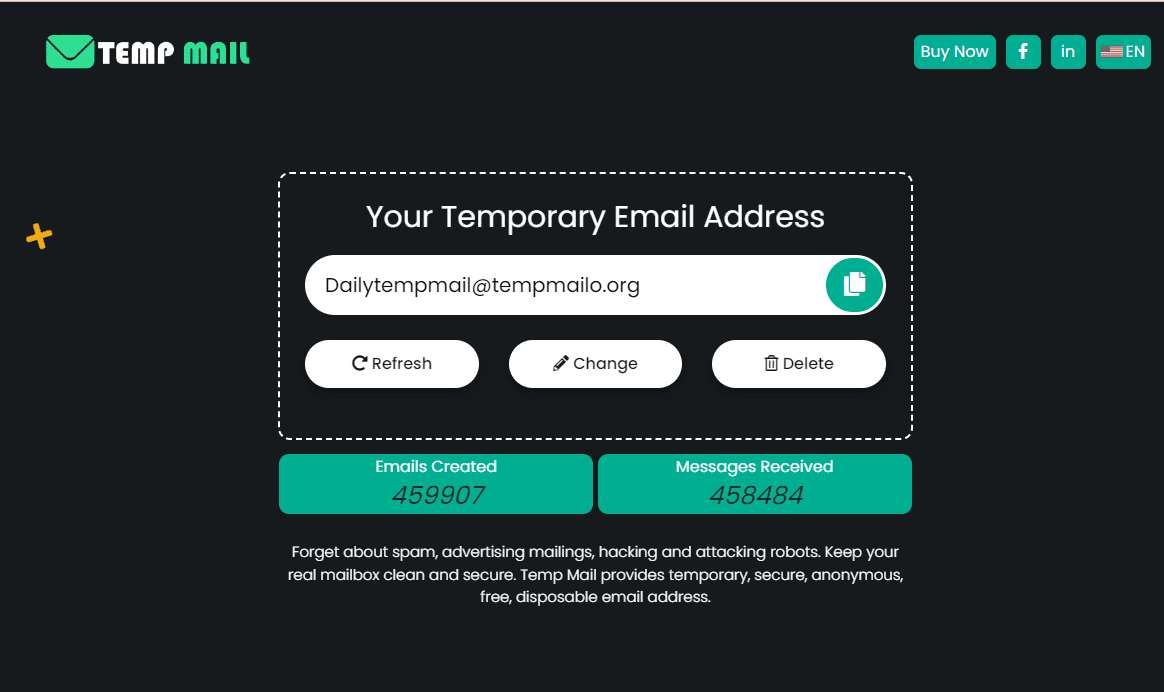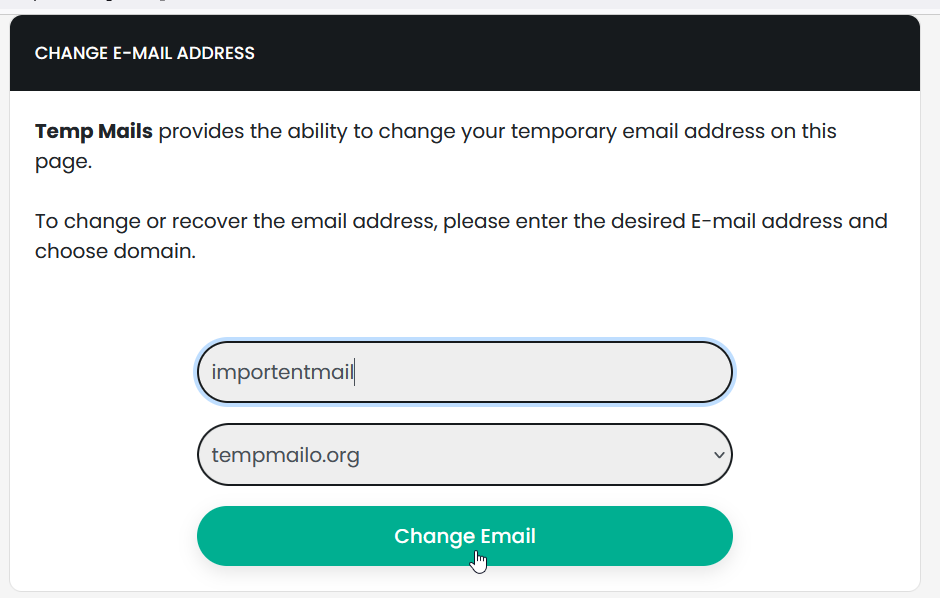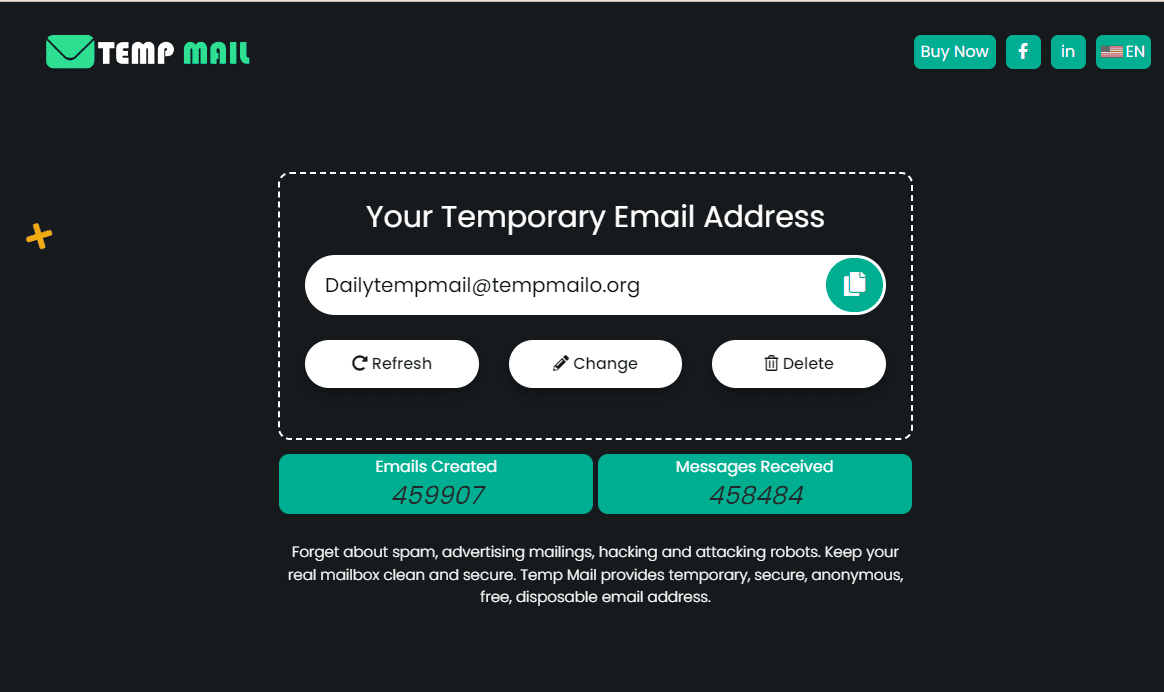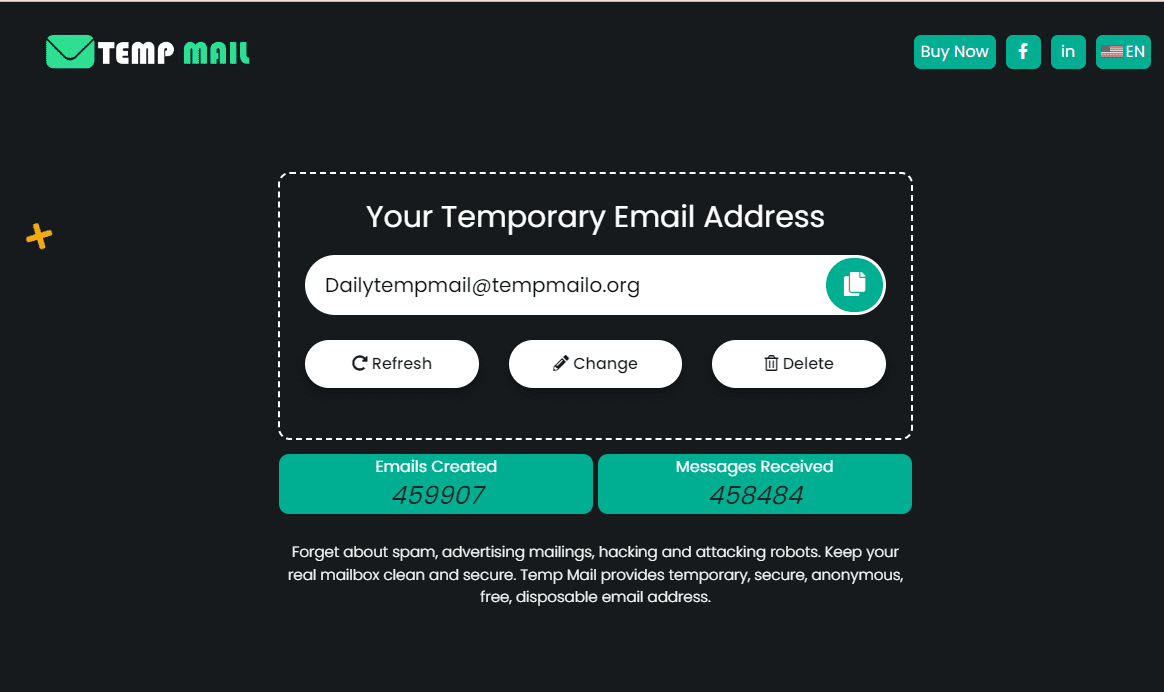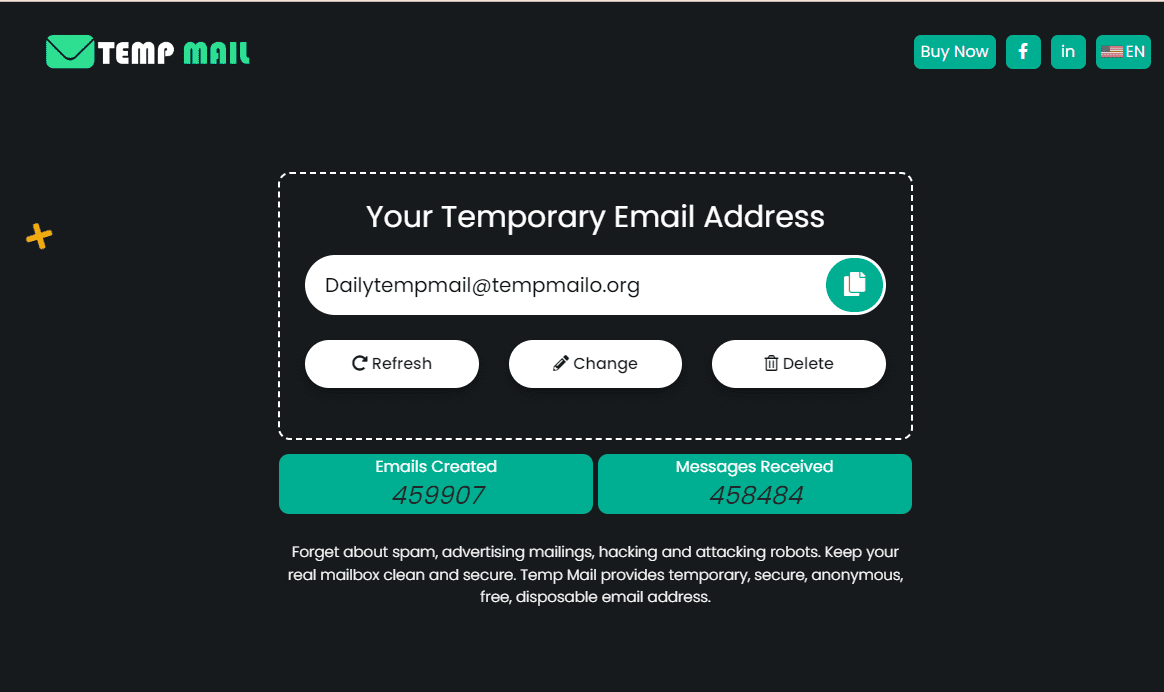In today's digital world, privacy is more important than ever. With the rise of online activities, our personal information is constantly at risk. Temp mail, also known as a disposable temporary email, offers a simple solution to protect your privacy.
Unlike regular email services, temp mail provides a temporary, anonymous email address that you can use for a short period. This type of email is ideal for situations where you need to sign up for a service but don’t want to share your personal email.
People use temp mail to avoid spam, safeguard their identity, and maintain privacy while navigating the internet. It's a quick and effective way to stay secure online without compromising your personal information.
What is Temp Mail?
Temp mail, or disposable temporary email, is a service that provides users with a temporary email address. Unlike traditional email accounts that require a lengthy sign-up process, temp mail allows you to quickly generate an email address that you can use for a limited time.
This address can be used for tasks like signing up for websites, receiving confirmation emails, or downloading resources without revealing your personal email.
Temp mail works by assigning you a randomly generated email address. You don’t need to provide any personal information to use it. Once created, this email address can receive messages just like a regular email account.
However, the key difference is that the emails and the address itself are typically deleted after a set period, usually within a few hours to a day, depending on the service.
In comparison to regular email services, temp mail is far more convenient for short-term use. While traditional emails require a permanent account that stores your messages indefinitely, temp mail is designed for temporary, often one-time use.
This makes it an ideal solution for situations where privacy is a concern, such as avoiding spam or protecting your identity when registering for services. However, it’s important to note that because temp mail is temporary, it’s not suitable for important communications or long-term use.
Unlike regular emails, which are linked to your identity and can be recovered if lost, temp mail offers no recovery options once the address is deleted.
Benefits of Using Temp Mail
Using temp mail offers several distinct benefits, making it a valuable tool for those who prioritize privacy and convenience in their online activities. Here are some key advantages:
1. Privacy Protection:
Temp mail is an effective way to safeguard your personal email from unwanted exposure. When you use a temporary email address, you can avoid sharing your primary email with websites and services that may later send spam or sell your information to third parties. This keeps your inbox clean and your personal information secure.
2. Anonymity:
Temp mail provides an extra layer of anonymity. Because it requires no personal information to set up, you can interact with websites, download resources, or sign up for newsletters without revealing your identity. This is especially useful when you want to participate in online forums or comment sections without linking your activity to your real email address.
3. Convenience:
Setting up a temp mail address is quick and easy. Unlike traditional email services that require a lengthy registration process, temp mail allows you to generate an email address instantly. This is ideal for situations where you need an email address immediately, such as when accessing content or verifying accounts on short notice.
4. Reducing Spam:
By using a temp mail address for online registrations, you can prevent your personal inbox from being flooded with promotional emails and spam. Once the temp mail address has served its purpose, it’s deleted along with any associated messages, leaving your primary email spam-free.
5. Security:
Temp mail minimizes the risk of your personal email being compromised in data breaches. Since the email is temporary and not linked to your identity, even if it were intercepted, the impact would be minimal.
Common Uses of Temp Mail
Temp mail, or disposable temporary email, is a versatile tool that serves various purposes in our increasingly digital lives. Here are some of the most common uses:
1. Signing Up for Online Services:
Many websites require an email address for registration, even if you only intend to use the service once. Using temp mail allows you to sign up without exposing your personal email to potential spam or marketing emails. This is especially useful for accessing promotions, trials, or one-time downloads.
2. Protecting Privacy in Online Forums:
When participating in online discussions or forums, temp mail helps keep your identity private. By using a disposable email address, you can engage in conversations without worrying about your personal email being linked to your online activity.
3. Avoiding Spam:
Temp mail is ideal for situations where you expect to receive a lot of promotional or unsolicited emails. By using a temporary address for these registrations, you can prevent your primary inbox from being flooded with spam.
4. Downloading Resources:
Many websites require an email address to access downloadable content like eBooks, whitepapers, or software. Temp mail allows you to access these resources without subscribing to ongoing communications or sharing your personal email.
5. Testing and Development:
For developers and testers, temp mail provides an easy way to create multiple email addresses for testing purposes without cluttering your personal or work inbox.
Potential Risks and Drawbacks
While temp mail offers several benefits, it also comes with potential risks and drawbacks that users should be aware of:
1. Limited Lifespan:
The temporary nature of temp mail means that the email address and its contents are usually deleted after a short period, often within hours or days. If you need to retrieve important information or follow up on a registration, the email may no longer be accessible.
2. Security Concerns:
Not all temp mail services are equally secure. Some may lack proper encryption or other security measures, making them vulnerable to interception by hackers. Additionally, since temp mail addresses are public, anyone with the same email address can potentially view your messages if they access the service after you.
3. Lack of Reliability:
Because temp mail addresses are designed for short-term use, they are not suitable for long-term communication. Important messages might be missed if they arrive after the temp mail address has expired, leading to potential disruptions in your activities or access to services.
4. Not Suitable for Important Communications:
Using temp mail for critical or sensitive communications is risky. Since these emails are not linked to your identity, recovery options are minimal if you lose access. It’s best to use temp mail for low-stakes situations where privacy and anonymity are more important than the ability to retrieve or track communications.
How to Choose a Temp Mail Service
Choosing the right temp mail service is essential to ensure your privacy and convenience. Here are some key factors to consider when selecting a temp mail provider:
1. Security Features:
The first thing to look for in a temp mail service is its security measures. Ensure the service offers encryption to protect your emails from unauthorized access. A good temp mail service should prioritize user privacy and keep your information secure. Check if the service has a clear privacy policy and doesn’t store your data longer than necessary.
2. Ease of Use:
A user-friendly interface is important, especially if you need a temporary email quickly. Look for a service that allows you to generate an email address with just one click, without requiring any personal information or registration. The simpler the process, the better the experience.
3. Reputation and Reviews:
Before choosing a temp mail service, research its reputation. Look for reviews from other users to see if they’ve had positive experiences. Pay attention to any complaints about security breaches or poor service. Reputable services often have a history of reliable performance and positive feedback.
4. Lifespan and Customization:
Different temp mail services offer varying lifespans for the emails they generate. Some services allow you to extend the lifespan of an email address if you need more time. Others offer customization options, like choosing a custom domain or creating multiple addresses. These features can be useful depending on your needs.
5. Additional Features:
Some temp mail services come with extra features like the ability to forward emails to your personal inbox, create aliases, or use a custom domain. These features can enhance the utility of temp mail, especially if you need more flexibility.
How to Create a Temporary Email Address : Step-by-Step Guide
Creating a temporary email address is a quick and easy process that allows you to protect your privacy and avoid spam. Here’s a step-by-step guide to help you set up a temp mail address:
Step 1: Choose a Temp Mail Service
Start by selecting a temp mail service that suits your needs. Popular options include Temp-Mail, 10MinuteMail, and Guerrilla Mail. Each service has its unique features, so choose one that aligns with your requirements for security, ease of use, and email lifespan.
Step 2: Visit the Temp Mail Website
Once you’ve chosen a service, visit its website. Most temp mail services do not require registration, so you won’t need to provide any personal information. The homepage usually displays a randomly generated email address that you can use immediately.
Step 3: Copy Your Temporary Email Address
On the service’s homepage, you’ll see a temporary email address that has been automatically generated for you. Copy this address to your clipboard. You can now use this email address to sign up for services, download resources, or perform other online activities where you want to protect your privacy.
Step 4: Use the Temp Mail Address
Paste the copied email address into the required fields on the website or service you are signing up for. Any emails sent to this address will appear on the temp mail service’s website. You can check your inbox by refreshing the page.
Step 5: Access Your Emails
Temp mail services typically display incoming emails directly on their website. You can view, download, or delete these emails as needed. Remember that the lifespan of these emails is limited, usually a few hours to a day, depending on the service.
Step 6: Dispose of the Email Address
Once you’ve finished using the temporary email address, there’s nothing more you need to do. The email address and its associated messages will be automatically deleted after the set time period. If you need another temp email, simply refresh the page or generate a new address.
Step 7: Consider Additional Features
Some temp mail services offer additional features like forwarding emails to your primary inbox or extending the lifespan of the email address. Explore these options if you need more flexibility.
Alternatives to Temp Mail
1. TempeMailo:
TempeMailo is another alternative for users seeking a straightforward temporary email solution. It provides the same basic functions as other temp mail services, allowing you to create a temporary email address quickly and without registration. It’s particularly useful for one-time use cases where you need an email address for short-term activities.
2. Email Aliases:
Email aliases allow you to create alternative addresses linked to your primary email account. For example, many email providers like Gmail and Outlook let you add a “+” sign and a keyword to your email address (e.g., yourname+shopping@gmail.com). Emails sent to this alias will still reach your main inbox, but you can easily filter or block them if they become spammy. This is a convenient way to manage different online activities without needing a completely separate email account.
3. Secondary Permanent Emails:
Creating a secondary permanent email account dedicated to non-essential activities, such as signing up for newsletters or online shopping, is another alternative. This approach allows you to keep your primary inbox clean while maintaining long-term access to the secondary account. It’s ideal for ongoing communications that you don’t want cluttering your main inbox.
4. Privacy-Focused Email Services:
For those who prioritize privacy, services like ProtonMail or Tutanota offer encrypted email accounts that emphasize security and anonymity. While these are not temporary, they provide a high level of privacy, making them suitable for users who want secure communication without sacrificing long-term access.
Conclusion
Temp mail offers a practical solution for protecting your privacy online. It helps you avoid spam, maintain anonymity, and manage temporary online activities without exposing your personal email.
Whether you’re signing up for a one-time service, downloading resources, or engaging in online forums, temp mail provides a convenient and secure way to interact online. However, it’s important to use temp mail wisely, especially for short-term needs where privacy is a priority.
For more critical or long-term communications, consider other secure options. In an era where digital privacy is constantly at risk, using tools like temp mail can help safeguard your personal information. Always prioritize privacy in your online interactions to keep your data safe and secure.
Frequently Asked Questions
1. What is temp mail and how does it work?
Temp mail is a service that provides a temporary email address for short-term use. You can use this address to receive emails without revealing your personal email. Temp mail addresses are automatically generated and can receive messages, but they are typically deleted after a set period, such as a few hours or days.
2. Why should I use a temp mail address instead of my personal email?
Using a temp mail address helps protect your privacy and reduce spam. It’s useful for one-time registrations, downloading resources, or signing up for services where you don’t want to disclose your personal email. It also helps keep your primary inbox clean and free of unwanted promotional emails.
3. Are temp mail services secure?
While many temp mail services offer basic privacy features, not all are equally secure. It's essential to choose a reputable service that provides encryption and has a clear privacy policy. However, temp mail should not be used for sensitive or critical communications due to its temporary nature.
4. Can I recover emails from a temp mail address after it has expired?
No, once a temp mail address expires, both the email address and any messages associated with it are typically deleted. Temp mail is designed for temporary use, so it’s not suitable for storing important or long-term communications.
5. Are there any alternatives to using temp mail?
Yes, alternatives include email aliases, which allow you to create variations of your primary email address for different uses, and secondary permanent email accounts for non-essential activities. Privacy-focused email services like ProtonMail or Tutanota also offer enhanced security and privacy, though they are not temporary.
